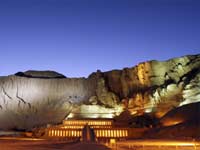Egypt - tourism
Bad breath and air could kill pharaohs' tombs, says Egypt
Article published on the 2009-08-18 Latest update 2009-08-18 16:18 TU
"The levels of humidity and fungus are increasing because of the breath of visitors and this means that the tombs could disappear between 150 and 500 years," said Hawass.
The tombs, which include the last resting place of legendary pharaohs such as Queen Nefertiti and boy king Tutenkhamun, are a big tourist attraction.
Egypt's Spureme Council of Antiquities have decided to protect the tombs and the mummies by setting up ventilation systems, restricting visitor numbers, and closing some tombs.
Nefertiti, Seti I and King Tut's tomb will be blocked from the view (and breath) of visitors, but Hawass said that identical replicas would be open to the public.
"A team of experts is currently using laser technology to examine these tombs in order to build the replicas... which would then open to visitors in a place near the Valley of the Kings," he added.
King Tut's tomb was discovered in 1922 by British archaeologist Howard Carter and caused an international sensation when the boy king's ornate sarcophagus was found covered in gold and semi-precious stones.
Tut, an 18th dynasty pharaoh, aceeded to the Egyptian throne at age nine in 1333 BC and died mysteriously aged 19 in 1324 BC.






